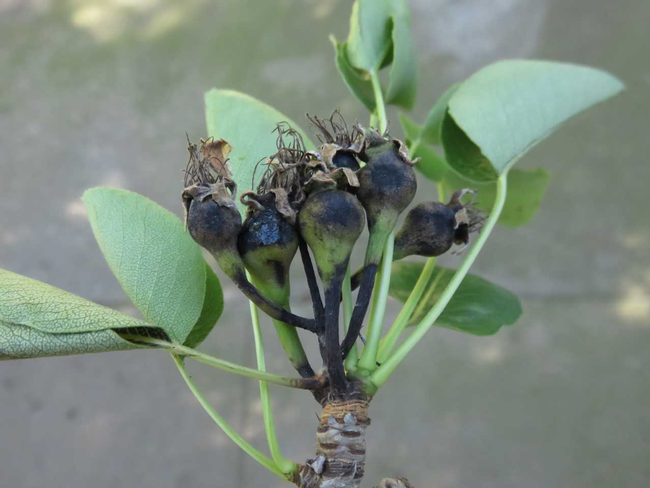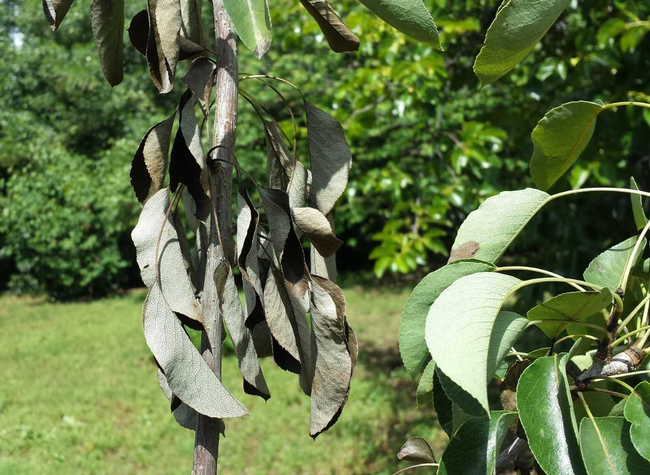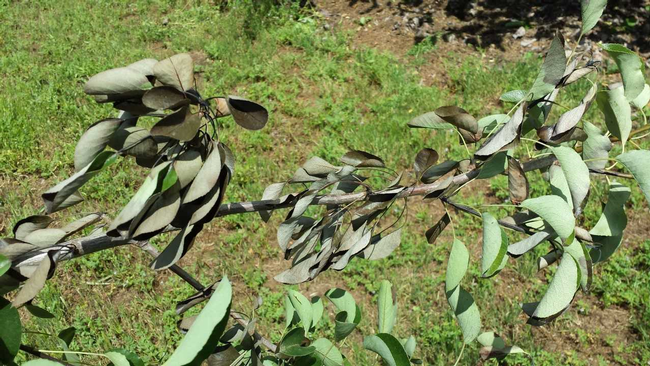By Lynnde Sharpton, UC Master Gardener of Butte County, June 1, 2018

Fire blight is caused by a bacterium and is a common and frequently destructive disease that shows up in April and May. Fire blight can also affect pyracantha, ornamental pear trees, and some other landscape plants.
The first sign of fire blight is often blackening of flowers, shoots or leaves followed by a watery, light tan ooze from affected shoots. Open flowers are the most common infection site and remain susceptible until petal fall.
Initially, fire blight infections might be localized, affecting only a flower cluster, but then the infection grows downward, extending into twigs and branches. These twig cankers kill more and more tissue as they advance. Dead, blackened leaves and fruit cling to dead branches throughout the season, giving the tree a scorched appearance -- hence the name “fire blight.” The pathogen can kill highly susceptible trees, while others may suffer significant branch dieback. Once infected, the plant will harbor the pathogen indefinitely unless the cankers are pruned out well below the infection.

Monitoring trees regularly, a couple of times a week, will allow you to identify and deal with new fire blight strikes before they become a branch infection. It is important to remove and destroy any new fire blight infections before they spread and affect more tissue. Dip pruning shears in a 10-percent bleach solution after each cut.
If fire blight strikes have been ignored, the infection will spread and infect the branch. Once the wood is infected, the branch must be pruned out well below the infection. In this case, you will need to remove the diseased wood in summer or winter when the bacteria are no longer spreading through the tree. Again, dip pruning shears in a 10-percent bleach solution after each cut.
It is critical to make your cuts in the right place. Find the lower edge of the visible infection in the branch, trace that back to the branch's point of attachment and cut at the next branch juncture down without harming the branch collar (this is the distinct enlarged portion of woody tissue formed at the base of a branch where it attaches to the trunk). This will remove the infected branch and the branch to which it is attached.

When selecting new fruit trees, choose those that are less susceptible to fire blight, if possible. The most susceptible varieties are Fuji, Gala, Golden Delicious, Granny Smith, Gravenstein, Jonathan, Mutsu, Pink Lady and Yellow Newton. Unfortunately, most pear varieties are susceptible to fire blight.
For more detailed information on identifying and controlling fire blight, see IPM Fire Blight Pest Notes.